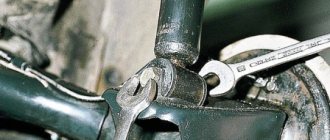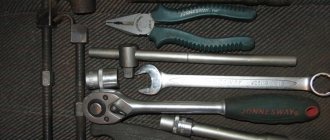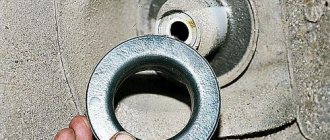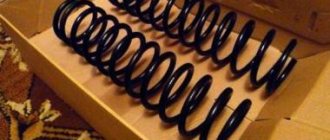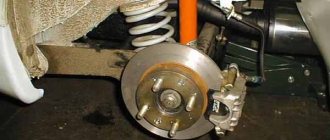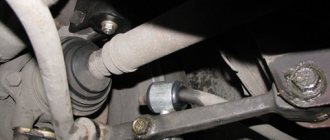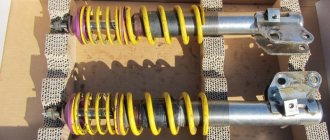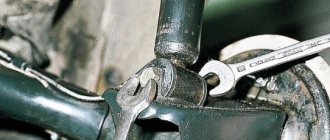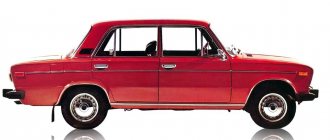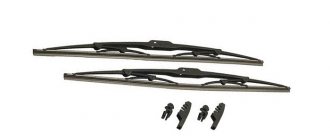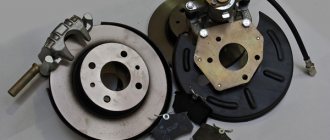On most passenger cars these are coil springs. Despite their simplicity and reliability, they fail over time.
After long-term (5–7 years) operation of the machine with a heavy load, they sag due to metal fatigue, while the travel and energy consumption of the suspension decrease. It starts to work all the way, which accelerates the destruction of body parts. Loss of spring elasticity is often discovered unexpectedly. For example, all summer two or three of us went to the dacha, but here we had to take guests and load the trunk thoroughly. The weight is no more than the permissible 400 kg for a Zhiguli, and the car is already “crawling on its belly,” clinging to the asphalt with its muffler.
But not all owners are in a hurry to buy new springs. Someone, having listened to other “experts”, installs rubber spacers under the springs (or between their coils). The main danger of such a solution is the possibility of the suspension being activated before the spring coils close and, as a result, almost hard impacts being transmitted to the body. In the standard design, the suspension makes its full stroke until it stops at a soft rubber or polyurethane bumper, which absorbs only the remaining energy. The spacer, replacing the air gaps between the coils of the spring, only limits the travel of the suspension, turning it from “soft spring” to “oak rubber”. If you transport a ton of cargo per trip on a VAZ-2104, then installing new springs to replace sagging ones is useless - and with them the loaded “four” will lie flat on the asphalt. And with spacers, the car will look “vigorous” for another year, until cracks in the side members disfigure its posture. The fact that the purchase of a new car will have to be taken into account in the estimate of upcoming production costs is not so bad. The main thing is that driving an overloaded car is simply dangerous. But if you use the car not so ruthlessly and count on its long service, there is only one way out - to install new springs designed for this model. For curious readers, we will tell you how suspension springs are made on a VAZ. The starting material is a rolled round rod made of spring steel grade 60S2GF. The first operation is processing of rods on turning lines to the required diameter, with removal of the top decarburized layer. The second is heating and spiral winding. Then – hardening and tempering. Then shot blasting: in a special chamber, the springs are fired with a stream of fine steel shot - this removes scale, strengthens the surface layer and increases fatigue strength. The next stage is cold draft, or spring captivity. They are compressed three times until the turns touch, after which the length decreases by approximately 18 mm from the original. Now the springs are ready to work for a long time without losing their elasticity. A protective coating is applied to the finished spring, otherwise, over time, cavities and cavities from corrosion will form on the surface of the rod, which will weaken the surface layer and accelerate the breakage of the spring. In addition to the traditional coating - black chlorinated rubber enamel, VAZ uses a more durable epoxy coating. For example, for rear suspension springs - only the latter. The final operation is static load control. 100% of produced springs pass it. Compressing the spring with a certain force, measure its length. For example, the spring of the “2101 front” model under a load of 435 kg has a nominal length of 232 mm, and at 603 kg - 182 mm. Springs whose length under load is greater or less (outside the tolerance) are rejected. Those that fall within the plus tolerance (that is, slightly longer than the nominal) belong to class A, and those within the minus tolerance (slightly shorter) – to class B.
Marking of springs for VAZ car suspensions
Color of distinctive markings
1111 front 1111 rear 2101 front 2101 rear 21012 front 2102 rear 2121 front 2121 rear 2108 front 2108 rear 2108 front European 2108 rear European 2110 rear 2111 rear 2112 front
yellow yellow yellow yellow white brown no mark (white) no mark (white) yellow yellow white brown no mark (white) orange white
green green green green blue blue black black green green blue blue black light blue no mark (black)
After this, the springs are marked by applying a strip of paint to the outer surface of the coils. Depending on the spring model (Table 1), yellow, green, white, blue, brown, dark blue, black and orange are used. And yet, despite such complex production technology, all springs sag sooner or later in operation. However, if you use more expensive material, you can create a spring that retains sufficient elasticity even with prolonged constraint. An example is the mainspring of a UZRGM grenade fuse. Being in a fully compressed state for fifty years, it slightly loses its elasticity and is always ready to work reliably, breaking the capsule with a striker. Of course, such high demands are not placed on car springs. What is the point of inflating their cost by making them “eternal” if in a few years more expensive components will require replacement? But the plant is obliged to ensure that the springs remain elastic at least during the design service life of the machine, and it succeeds. The same cannot be said about the “leftist” manufacturers whose springs appear on the market. But there are also conscientious manufacturers who have received VAZ approval to supply springs for spare parts. For example: construction machinery plant in Slavyansk; Crane manufacturing plant in Nikopol (both in Ukraine); Soyuz-TMO LLP, Izhevsk and Machine-Building Plant, Perm. The springs from these four factories are marked with the manufacturer's mark or a tag is attached. Now about the applicability of springs. Model 2101 (front and rear) - for all rear-wheel drive VAZs with a sedan body. 21012 - made of a larger diameter rod, it is stiffer than 2101. It is installed on the right side of the front suspension of Zhiguli with right-hand drive (export) to level the car due to asymmetrical weight distribution. On left-hand drive vehicles, the total weight of the steering mechanism, pedal assembly, hydraulic brake and clutch units, and instrument cluster located on the left side approximately corresponds to the weight of the battery, starter and generator on the right. With right-hand drive, all this is concentrated on one side, which required a reinforced spring on the right. Spring 21012 is also found on both sides of the suspension of Zhiguli special configurations with left-hand drive, which require increased energy intensity of the front suspension. Springs 2102 are installed in the rear suspensions of VAZ-2102 and 2104 station wagons. Their length is 21 mm longer than that of conventional “zero first” ones, and using them on sedans is justified only to increase the height of the body above the road, for example, if you have to often drive along a country road and hit bumps with the thresholds. But this does not mean that springs 2102 can be used to increase the load capacity of the machine - premature destruction of the body in this case is inevitable. Front springs 2108 are installed on all front-wheel drive VAZ models, except for the Oka and modifications with the new 16-valve engine. 2108 rear - for all front-wheel drive vehicles, except for the VAZ-2110 and Oka family. Owners of VAZ-21099 sedans are sometimes deceived in the markets by offering supposedly scarce “99” rear springs at exorbitant prices. Remember: these do not exist - the rear suspension of the VAZ-21099 has ordinary “eighth” springs. Springs for cars of the VAZ-2110 family are not yet in demand; however, we report data on their applicability (Table 2).
Properties of suspension springs
When torsion bars on vehicles were replaced with springs, handling improved and suspensions became more convenient to maintain. Springs maintain the vehicle's ground clearance, reducing vibrations and shocks while the vehicle is moving.
To make the ride comfortable, you need to choose the right parts. If the technical characteristics are unsuitable, then the positive properties of the suspension will be reduced to zero. Therefore, it is important to consider the following parameters:
- diameter - its increase affects rigidity;
- number of turns - as the number increases, the rigidity decreases;
- form.
Often, car owners strive to install stiffer parts in the suspension. This helps to increase the sensitivity of the steering wheel to the driver's control, but the grip on the road deteriorates.
Suspension springs
What are suspension springs used for?
The operation of springs without shock absorbers is impossible. Shock absorbers + springs together ensure smooth movement of the car body even on very bad roads and help maintain controllability. It is the spring and shock absorber strut that take on the entire weight of the car while overcoming bumps, unloading the suspension.
What function does a spring perform?
The spring has a spiral shape and consists of several turns. The main characteristics of springs are:
- Hardness (indicated kgf/cm),
- Free length (mm)
- Loaded length (mm)
- Bar diameter (mm)
sometimes the spring is additionally marked with color or notches indicating its stiffness
When the car moves over uneven surfaces, the wheel may lose contact with the road, and the spring, compressing or straightening, returns it to work. During the collision of the wheel and the road surface, the entire mass of the body goes down, and the spring softens the consequences of this contact.
Dimensions and characteristics of suspension springs for VAZ, NIVA, Moskvich, OKA, UAZ
| Catalog number | Rod diameter, mm | Free length mm | Hardness, kgf/cm | Load X, kg | Load length X, mm | Diameter, mm | |
| Front spring 2101,2102,2103,2104,2105,2106,2107 | 2101-2902712 | 13,13 | 360mm | 35,3±1,1 | 450±15 | 232 | 118mm |
| Rear spring 2101,2103,2105,2106,2107 | 2101-2912712 | 12,4 | 434mm | 18,9±0,57 | 305±13 | 273 | 124 |
| Rear spring 2102,2104 | 2102-2912712 | 12,4±0,05 | 455mm | 18,9±0,57 | 335±13 | 278 | 124 |
| Front spring 2108-099,2110,2111,2113,2114,2115 | 2108-2902712 | 12,9±0,05 | 383.5mm | 19,0±0,6 | 325±12 | 211 | |
| Rear spring 2108, 2109, 21099, 2113, 2114, 2115 | 2108-2912712 | 11,15±0,05 | 418mm | 17,1+0,7-0,3 | 295±13 | 245 | 108 people |
| Front spring 2112 | 2112-2902712 | 13,2±0,05 | 383.5mm | 21±0,75 | 355±14 | 211 | |
| Rear spring 2110, 2112 | 2110-2912712 | 11,6±0,05 | 403mm | 19,7±0,60 | 325±14 | 240 | |
| Rear spring 2111 | 2111-2912712 | 11,6±0,05 | 418mm | 20,8±0,62 | 350±14 | 240 | |
| Front spring 2121 | 2121-2902712 | 15,2±0,05 | 278mm | 74,42 | 815 | 168 | 120mm |
| Rear spring 2121,21213,21214 | 2121-2912712 | 13 | 434mm | 22,44 | 483 | 219 | 124mm |
| Front spring 21214, 21214M | 21214-2902712 | 15,2±0,043 | 289mm | ||||
| Front spring 2129, 2131 | 2129-2902712 | 16±0,05 | 273mm | 89,56 | 815 | 182 | |
| Rear spring 2129, 2131 | 2129-2912712 | 14,2 | 405mm | 30,96 | 483 | 249 | |
| Front spring 2120 Nadezhda | 2120-2902712-10 | 16,2±0,05 | 281mm | 88,59 | 815 | 189 | |
| Rear spring 2120 Nadezhda | 2120-2912712-10 | 14,3 | 421mm | 30,96 | 483 | 265 | |
| Front spring 2123 | 2123-2902712 | 15,7 | 313mm | 75 | 815 | 204 | |
| Rear spring 2123 | 2123-2912712 | 13,9 | 410mm | 30 | 483 | 249 | |
| Front spring OKA-1111 | 1111-2902712 | 10,1±0,05 | 317.7mm | 21,35±0,6 | 230±9 | 210 | 95 |
| Rear spring OKA-1111 | 1111-2912712 | 9,7±0,045 | 353mm | 14,19±0,4 | 210±10 | 205 | 99,7 |
| Front spring M2141 | 2141-2902712 | 13,7-0,043 | 460mm | 15,6±0,5 | 350±8 | 216 | |
| Rear spring M2141 | 2141-2912712 | 13,1-0,043 | 340mm | 31,0±1,0 | 310±10 | 240 | |
| Front spring IZH-2126, 2717, 27171 | 2126-2902712 | 13,5-0,043 | 422±6mm | 16,0±0,5 | 330±15 | 205 | |
| Rear spring IZH-2126 | 2126-2912712 | 12,3-0,043 | 387±6mm | 17,6±0,53 | 318…335 | 205 | 132 |
| Front spring IZH-2125, 2715 | 402-2902712 | 14,7-0,05 | 260±3.5mm | 74,0±4,0 | 635…670 | 165 | |
| Rear springs IZH-21261 | 21261-2912712 | 12,7-0,043 | 387±6mm | 19,8±0,62 | 360…378 | 205 | |
| Front spring GAZ-3110 | 24-2902712 | 15 | 370mm | 53 | 595…625 | 251 | |
| Front spring GAZ-21 | 16,3 | 323mm | 72 | 620 | 236 | 89 internal | |
| Front spring GAZ- 24, 3110 (Steyer) | 17,0 | 320 | 84 | 707 | 236 | 90 internal | |
| Front spring GAZ- 24, 3110 pivoted 31105 pivotless | 24-2902712 | 15,0 | 350 | 53 | 710 | 236 | 89 internal |
| Front spring UAZ-3151, 3153, 3160, 3162, PATRIOT | 3160-2902712 | 15 | 378mm | 400±15 | 130 | ||
| Front spring UAZ-2966, 3160, 3162, PATRIOT, reinforced | 2966-2902712 | 16 | 378mm |
Spacers for rear springs M2141 reinforced:
Spacers for springs 01-07,2121,2123 rear reinforced:
Front standard spacers for springs 01-07,2121,2123:
Spacers for springs 01-07,2121,2123 front reinforced:
Correspondence of spring markings to the model
When installing springs on a VAZ suspension, it is advisable to ensure their compliance.
- 2101 install on rear-wheel drive sedans.
- 21012 is tougher, made from a larger diameter rod. Installed on a VAZ with left-hand drive, with special equipment, when a front suspension with increased energy intensity is needed.
- 2102 are installed on station wagons VAZ-2102, 21014. Their length is increased by 21 mm compared to 2101, so they are installed on sedans only when you often have to drive on country roads so as not to hit bumps - when installing 2102, the ground clearance under body They cannot be used to increase the load capacity, since they inevitably lead to premature destruction of the body.
- 2108 is installed on all front-wheel drive models, except for modifications with a 16-valve engine and Oka. By the way, in the markets they often deceive owners of VAZ-21099 sedans by offering to purchase scarce “99 springs”. In fact, there are ordinary “eighths” there, and “99ths” do not exist at all.
- 2110 European ones are installed on the rear suspensions of VAZ 21102-21104, 2112, 2114, on the front and rear suspensions 21122 and 21124. The European version is created for cars intended for export. The ground clearance here is reduced by 20 mm, the compliance of the springs is reduced in order to increase their stability at high speed when turning. The cross-country ability of vehicles on off-road and dirt roads is significantly deteriorated.
- 2111 are installed on the rear suspensions of VAZ 2111 and 2113.
- 2112 are installed on the front suspensions of VAZ 21103, 2112, 21113.
- 2121 is used on all-wheel drive models, except Oka.
What springs to choose for a VAZ 2112?
For the entire family of 16-valve tens with various modifications, including the 2112 hatchback, the standard equipment consists of: front reinforced springs 2112 and rear 2110, with the exception of the 2111 station wagon. Due to its specifics, there are special rear springs that are longer 418 mm.
Judging by the fact that the original rear springs are 418 mm long, and this often happens, your 2112 has the same equipment as the VAZ 2111 station wagon with increased load capacity, respectively, the springs that you wanted to install will be suitable as an analogue. You can ignore the length of the spring, since the length in the compressed state is important, and a difference of one and a half centimeters will not play a significant role.
Springs 2108 were installed on the first eight-valve tens. As can be seen from the table, they have the same dimensions as 2112, with the exception of the thickness of the rod.
Table of standard springs for VAZ 2110 - 2112
| Spring models | 2108 | 2110 | 2111 | 2112 |
| Articles | 2108-2902712 | 2110-2912712 | 2111-2912712 | 2112-2902712 |
| Rod diameter, mm. | 12,9 | 11,6 | 13,2 | |
| Inner diameter of the spring, mm. | 124,8 | 84,8 | 124,8 | |
| Total number of turns | 7 | 11 | 7 | |
| Spring height, mm. | 383,5 | 403 | 418 | 383,5 |
| price, rub. | 1050 | 1800 | 2150 | 1830 |
It is recommended to change springs in pairs along one axis and simultaneously with shock absorbers. If only one new spring is replaced, the car will hold the road poorly and driving performance will noticeably deteriorate.
There is also a division of springs into classes “A” and “B”. Depending on the class, springs are marked with color marks, and they are different for different manufacturers.
By choosing class “B”, you can make the suspension softer, and class “A”, being stiffer, is suitable for frequent periodic loads. On 2112, the original springs are distinguished by the following color scheme: the front ones (model 2112) are white without class “A” marks, and the rear springs (2110) are black without marks corresponding to class “B”.
Designation of the stiffness class on the package with springs
When installing new springs, it is recommended to maintain the same class for both front and rear. As a last resort, you can install “A” on the front and “B” on the back, but in no case vice versa!
When selecting analogues, it is not recommended to take original springs made for export, since they are shorter in length and will significantly reduce the vehicle’s ground clearance. There are also foreign analogues made of higher quality than the original ones.
The Phobos company produces many options for rigidity and length of one model, and the selection must be made individually depending on the task at hand - increase the load capacity, increase the ground clearance for off-road or sports with increased resistance during loads.
Table of recommended analogues:
| Spring model | Analog article | price, rub. |
| 2108 | KYB RA 1904 | 920 |
| SS20 SS30101 | 1500 | |
| Original RG2108-2902712 | 805 | |
| 2110 | KYB RA 5649 | 990 |
| SS20 SS30104 | 1450 | |
| Stellox 10-20379-SX | 1020 | |
| 2111 | KYB RA 5648 | 950 |
| Fobos 78589 | 710 | |
| Killen 55032 | 1500 | |
| 2112 | SS20 SS30102 | 1500 |
| Fobos 69696 | 740 | |
| Suplex 14 014 | 710 |
Choice depending on manufacturer
Often, when parts break down, drivers try to buy original factory parts as replacements, not wanting to experiment. However, there is a decent choice from other manufacturers, whose products are sometimes no worse than the original ones.
Sirius
There is a large assortment for different brands of cars, and parts are also manufactured in any configuration according to customer drawings.
Phobos
The quality is satisfactory, but, according to some car enthusiasts, after 2 years they begin to sag, losing rigidity. In total, about 500 types of springs are manufactured under this brand for any brand of car; there are standard, reinforced and lowered springs. Clearance kits with increased ground clearance are also available.
Technospring
Good quality for little money. They lose rigidity over time, but do not sag. Quite good as a budget option.
Very durable, no sagging. They have a stiffness adjustment directly on the car, done with a special thumb under the hood.
Eibach
High-quality, very durable, practically do not “age” - do not sag, do not lose rigidity. There is no roll when turning. But they cost one and a half times more than Koni.
Products of the SS20 brand undergo mandatory testing at test benches, after which they are selected in pairs with similar characteristics. This check ensures, according to the manufacturer, 100 percent product quality. A large assortment allows you to choose the right characteristics depending on your driving style and operating conditions. There are 3 options available:
- hot coiling of standard height with linear compression characteristic;
- cold coiling of standard height with linear and progressive compression characteristics;
- cold coils are lowered, with a progressive compression characteristic.
Kilen
Alternative original springs from Kilen are of the highest quality. The service life, as the manufacturers claim, is twice as long as the original VAZ products.
Asomi
Excellent springs made from special alloys, coated with epoxy coating to increase service life.
Installation Tips
- Is it possible to install parts of different classes?
Remember that the springs on the suspension must be of the same class. Let’s say you installed A-class parts on the front suspension, which means you also need to install “A” class on the rear suspension.
If a similar class is not available for the rear suspension, then in exceptional cases class “B” is assigned to the rear suspension.
If B-class springs are installed on the front suspension, then class “A” springs cannot be installed on the rear suspension.
Install suspensions of the same class on the left and right sides of the same axle.
Rear spring size of VAZ 2110. Trading House "Zarechny"
The springs of models “21” and “20” are very similar in appearance, made from the same rod (16.3 mm in diameter) and equal in coil diameter. The only difference is the length. In the free state, the new spring of the Volga GAZ-21 has a height of 323 mm, the Pobeda - 311. The spring stiffness of both models is 72 kg/cm. Notches are applied at the ends of the turns. This is a breakdown of the degree of hardness within the tolerance. Three notches - the greatest rigidity. Springs from model “24” have lower rigidity (53 kg/cm) and height (250 mm) and are wound from a rod with a diameter of 15 mm. They are not suitable for installation on the GAZ-21.
Characteristics of springs for GAZ-3110 Springs are divided into 4 groups depending on their stiffness and, accordingly, the number of marks applied to the lower, unpolished end of the spring. Group N1 Load 595-605 kgf - one notch Group N2 Load 605-615 kgf - two notches Group N3 Load 615-625 kgf - three notches
The factory does not recommend installing springs and springs of different stiffness on different sides - the suspension will go screwy (the car will be skewed, headlight adjustment will be disrupted, shock absorbers will not work correctly, etc.) As a last resort, it is allowed to install springs of the next category, with a stiffer one being installed on the left side (where the driver sits).
Official information from the GAZ website. Is it true that stiffer springs are selected for GAZ-3102 cars with a ZMZ-406 engine?
Springs 24-2902712 produced by GAZ OJSC have from 1 to 4 notches in terms of stiffness - in increasing order it looks like this - 4, 1, 2, 3. When assembling the front suspensions, the springs are selected among themselves so that the suspension has springs of equal stiffness outside depending on the model and installed engine. Other, more powerful springs 23-2902712 were installed only on Volga modifications with a GAZ-560 Steyr engine.
| GAZ-21 | GAZ-23, GAZ-24-24, GAZ-3110 Steyr | GAZ-24, GAZ-3110 pivot, GAZ-31105 non-pivot |
| Number of turns | ||
| Bar diameter | ||
| Spring diameter (internal) | ||
| Free height | ||
| Height under load kgf | ||
| Rated spring load (at full vehicle load) | ||
| Hardness, kgf |
21/23/24 Height under control load - 236 mm for all.
Control load - 620 / 707 / 605 kg. These are not nominal parameters, but only test conditions at the stand. But it is quite possible to judge from them the ratio of heights with a total load. It turns out that, for example, under a load of 610 kg, the 21st will be higher than 236mm, and the 24th will be lower. Those. 24th is softer. By the way, here is the hardness data: 72 / 84 / 53 (units not indicated). The number of turns everywhere is 10. The rod is 16.3 / 17 / 15, respectively. This information was provided by Ruslan (762V) GAZ-21 springs are divided according to their stiffness into four groups, each of which has its own marking: from one to four notches on the support turn. The stiffness is determined by the load required to compress the spring to a height of 236 mm when installed on the control washer. The first hardness group (one risk) corresponds to a load of 605-615 kg; second group (two risks) -615-625 kg; third (three risks) - 625-635 kg; fourth (four risks) - 595-605 kg. On a car, all springs must be of one group.
› ONCE AGAIN ABOUT VAZ SUSPENSION SPRINGS
How springs are marked and how to choose them correctly
The technology for making springs is quite complex. That’s why the lion’s share of springs for Zhiguli, Samar, and Niv are produced at VAZ. However, there are still a number of enterprises that have received VAZ permission to produce springs. The manufacturer's trademark is applied to them or a tag is attached. Springs are made from rolled spring steel, from which the decarbonized layer is first removed by grinding (on new lines - by turning).
Further production of the spring is divided into the following stages:
1. heating the rod and coiling the spring in a hot state; 2. oil quenching and low tempering; 3. shot blasting, used to remove oxidation products and harden the surface layer; 4. cold draft of the springs (the springs are pressed three times until the coils touch, their length decreases by approximately 18 mm, and at the same time the springs become “unwilling”); 5. application of a protective coating - a protective epoxy coating is applied to the rear suspension springs operating in more severe conditions. The front springs can be coated with a special black enamel based on chlorinated rubber. It is worth noting that the technology for applying epoxy coating is quite complex and was mastered only at the Volzhsky Automobile Plant. Other manufacturers, as a rule, use enamel coating of springs; 6. Static load control is the last operation in the manufacture of springs. At this stage, which absolutely all products go through, springs that do not fall within the tolerance are rejected, and the rest, depending on the obtained control load value, are divided into two classes. Springs with a positive load tolerance range belong to class A, and those with a minus tolerance – to class B. In this case, the springs are marked with paint (a stripe is applied with a spray on the outside of the coils) corresponding to the class.
Table 1 shows the markings of produced springs
Suspension springs - dimensions/markings
It shows that most of the springs installed on cars are marked with either yellow or green paint.
The question quite reasonably arises: which springs are preferable?
Strictly speaking, both
class A
and
class B
have an equal right to exist.
The division into classes was adopted in order to reduce the difference in the length of the springs on the right and left sides of the car - and this is inevitable in mass production - which negatively affects its controllability and stability (as it leads to the car being skewed relative to the longitudinal axis). However, if you prefer to load your car to capacity, then you may want to choose Class A
, as they can withstand a little more load. But it should be borne in mind that the difference (which is impossible to control) is insignificant and can range from 0 to 25 kg.
Spring marking colors for VAZ, GAZ, IZH, ZAZ, AZLK
If you carefully study the table, you will see that there are markings in other colors.
Let's take a closer look at it. These are springs designed primarily for installation on the rear suspension of station wagons. Previously - VAZ-2102, now - VAZ-2104 and VAZ-2111. They differ in slightly longer length due to the specifics of these cars. Can these springs be installed on sedans or hatchbacks?
To answer this question, you need to know the purpose of installing these springs. If this is due to the desire to increase ground clearance due to body sagging associated with aging, then this installation makes sense. This will in no way affect the driving performance of the car. However, if such a rearrangement serves the purpose of increasing the vehicle load beyond the permissible norm, then this operation will entail premature wear and destruction of the body. And here the car enthusiast must decide for himself what is more important for him: keeping the car in technically sound condition for many years or getting the most out of it in a short time, and then scrapping it with a light heart.
Spring color
– the value is not constant.
Different manufacturers may change this color. The thickness of the rod is also a question; for example, Phobos
makes springs even with variable rod thickness. He (Phobos) makes springs with variable pitch, therefore, cannot withstand the specified number of turns. The height can also vary, because... Some manufacturers, to simplify the technology, make the rear springs 2101 and 2102/04 the same height, but of different stiffness. Other manufacturers reduce the height to increase the stability of the car in corners. Therefore, to identify springs, it is most appropriate to use the outer diameter of the spring, because this size is attached to the car, and spring manufacturers cannot change it arbitrarily. Springs of the same diameter can be distinguished by the color of the marking, because... this is also an established standard with some tolerance for color perception (for example, red = brown).
Installing springs that are not provided for by the design and loading the car beyond measure will not prolong its life. The same can be said about spacers, which are often installed between the spring and the body. If the spring sag, then no spacer will save it, since in such a spring the interturn distance is reduced, and this is dangerous because the spring stroke before the turns close is reduced. If such a spacer is used together with a normal spring, then this will increase the ground clearance, but at the same time the rebound stroke will decrease and the compression stroke of the shock absorber will increase, which in general is also not very pleasant. Finally, it is completely stupid to stick rubber inserts between the coils of a sagging spring. The spring simply ceases to perform its functions and at one point may simply burst, if before that you have not yet managed to fly into a ditch due to the disgusting handling of the car.
Now let’s look in more detail at the non-standard springs that AvtoVAZ used on its cars over the years. Springs - 21012.
They are made from a rod of a larger diameter than conventional springs, and are installed only on the right side of the front suspension of cars with a classic layout with right-hand drive to level the car due to significant redistribution of weight.
In addition, the same springs are installed on individual vehicles with left-hand drive (on both sides). Springs - 2108
in export version. They are marked with white and blue colors for the front ones and brown and blue for the rear ones. Our advice: stay away from these springs. After all, their only difference is that a car with these springs has a reduced ground clearance and they are intended for driving on European autobahns, and not on native potholes.
If they offer you springs - 21099
(and they have been showing up in advertising lately), then know that they just want to “heat you up.”
There are no “99” springs in nature. Springs - 2110. Springs
- 2108 are installed on the front suspension of the VAZ-2110 car as standard. “Tens: with a 16-valve engine are equipped with reinforced springs - 2112. And at the rear of this family springs are most often installed - 2110 euros (except VAZ-2111 ).
Next, let's talk about the rules for installing springs that exist at the Volzhsky Automobile Plant.
Firstly, it is allowed to install only one class of springs on the suspension of one car.
In exceptional cases, if class A
class B
springs on the rear suspension .
For a car equipped with class B
class A
springs on the rear suspension is unacceptable. It should be noted that in any case, springs of the same class must be installed on the right and left sides of the same vehicle axle.
In general, despite the apparent simplicity of the part we are describing, it is absolutely impossible to determine its suitability in garage conditions (and even in service station conditions). To do this, you need rather bulky special equipment that allows you to load the spring and determine the degree of compression depending on the applied load. Attempts by anyone to restore old springs also seem like a thankless task. Relevant studies were carried out at AvtoVAZ, and based on the results obtained, it was concluded that the game is not worth the candle, since the service life of the restored spring is very small.
Like 65 Share: Follow this User
On most passenger cars these are coil springs. Despite their simplicity and reliability, they fail over time.
After long-term (5–7 years) operation of the machine with a heavy load, they sag due to metal fatigue, while the travel and energy consumption of the suspension decrease. It starts to work all the way, which accelerates the destruction of body parts. Loss of spring elasticity is often discovered unexpectedly. For example, all summer two or three of us went to the dacha, but here we had to take guests and load the trunk thoroughly. The weight is no more than the permissible 400 kg for a Zhiguli, and the car is already “crawling on its belly,” clinging to the asphalt with its muffler. But not all owners are in a hurry to buy new springs. Someone, having listened to other “experts”, installs rubber spacers under the springs (or between their coils). The main danger of such a solution is the possibility of the suspension being activated before the spring coils close and, as a result, almost hard impacts being transmitted to the body. In the standard design, the suspension makes its full stroke until it stops at a soft rubber or polyurethane bumper, which absorbs only the remaining energy. The spacer, replacing the air gaps between the coils of the spring, only limits the travel of the suspension, turning it from “soft spring” to “oak rubber”. If you transport a ton of cargo per trip on a VAZ-2104, then installing new springs to replace sagging ones is useless - and with them the loaded “four” will lie flat on the asphalt. And with spacers, the car will look “vigorous” for another year, until cracks in the side members disfigure its posture. The fact that the purchase of a new car will have to be taken into account in the estimate of upcoming production costs is not so bad. The main thing is that driving an overloaded car is simply dangerous. But if you use the car not so ruthlessly and count on its long service, there is only one way out - to install new springs designed for this model. For curious readers, we will tell you how suspension springs are made on a VAZ. The starting material is a rolled round rod made of spring steel grade 60S2GF. The first operation is processing of rods on turning lines to the required diameter, with removal of the top decarburized layer. The second is heating and spiral winding. Then – hardening and tempering. Then shot blasting: in a special chamber, the springs are fired with a stream of fine steel shot - this removes scale, strengthens the surface layer and increases fatigue strength. The next stage is cold draft, or spring captivity. They are compressed three times until the turns touch, after which the length decreases by approximately 18 mm from the original. Now the springs are ready to work for a long time without losing their elasticity. A protective coating is applied to the finished spring, otherwise, over time, cavities and cavities from corrosion will form on the surface of the rod, which will weaken the surface layer and accelerate the breakage of the spring. In addition to the traditional coating - black chlorinated rubber enamel, VAZ uses a more durable epoxy coating. For example, for rear suspension springs - only the latter. The final operation is static load control. 100% of produced springs pass it. Compressing the spring with a certain force, measure its length. For example, the spring of the “2101 front” model under a load of 435 kg has a nominal length of 232 mm, and at 603 kg - 182 mm. Springs whose length under load is greater or less (outside the tolerance) are rejected. Those that fall within the plus tolerance (that is, slightly longer than the nominal) belong to class A, and those within the minus tolerance (slightly shorter) – to class B.
| Table 1 | ||
| Marking of springs for VAZ car suspensions | ||
| Spring model | Color of distinctive markings | |
| 1111 front 1111 rear 2101 front 2101 rear 21012 front 2102 rear 2121 front 2121 rear 2108 front 2108 rear 2108 front European 2108 rear European 2110 rear 2111 rear 2112 front | yellow yellow yellow yellow white brown no mark (white) no mark (white) yellow yellow white brown no mark (white) orange white | green green green green blue blue black black green green blue blue black light blue no mark (black) |
After this, the springs are marked by applying a strip of paint to the outer surface of the coils. Depending on the spring model (Table 1), yellow, green, white, blue, brown, dark blue, black and orange are used. And yet, despite such complex production technology, all springs sag sooner or later in operation. However, if you use more expensive material, you can create a spring that retains sufficient elasticity even with prolonged constraint. An example is the mainspring of a UZRGM grenade fuse. Being in a fully compressed state for fifty years, it slightly loses its elasticity and is always ready to work reliably, breaking the capsule with a striker. Of course, such high demands are not placed on car springs. What is the point of inflating their cost by making them “eternal” if in a few years more expensive components will require replacement? But the plant is obliged to ensure that the springs remain elastic at least during the design service life of the machine, and it succeeds. The same cannot be said about the “leftist” manufacturers whose springs appear on the market. But there are also conscientious manufacturers who have received VAZ approval to supply springs for spare parts. For example: construction machinery plant in Slavyansk; Crane manufacturing plant in Nikopol (both in Ukraine); Soyuz-TMO LLP, Izhevsk and Machine-Building Plant, Perm. The springs from these four factories are marked with the manufacturer's mark or a tag is attached. Now about the applicability of springs. Model 2101 (front and rear) - for all rear-wheel drive VAZs with a sedan body. 21012 - made of a larger diameter rod, it is stiffer than 2101. It is installed on the right side of the front suspension of Zhiguli with right-hand drive (export) to level the car due to asymmetrical weight distribution. On left-hand drive vehicles, the total weight of the steering mechanism, pedal assembly, hydraulic brake and clutch units, and instrument cluster located on the left side approximately corresponds to the weight of the battery, starter and generator on the right. With right-hand drive, all this is concentrated on one side, which required a reinforced spring on the right. Spring 21012 is also found on both sides of the suspension of Zhiguli special configurations with left-hand drive, which require increased energy intensity of the front suspension. Springs 2102 are installed in the rear suspensions of VAZ-2102 and 2104 station wagons. Their length is 21 mm longer than that of conventional “zero first” ones, and using them on sedans is justified only to increase the height of the body above the road, for example, if you have to often drive along a country road and hit bumps with the thresholds. But this does not mean that springs 2102 can be used to increase the load capacity of the machine - premature destruction of the body in this case is inevitable. Front springs 2108 are installed on all front-wheel drive VAZ models, except for the Oka and modifications with the new 16-valve engine. 2108 rear - for all front-wheel drive vehicles, except for the VAZ-2110 and Oka family. Owners of VAZ-21099 sedans are sometimes deceived in the markets by offering supposedly scarce “99” rear springs at exorbitant prices. Remember: these do not exist - the rear suspension of the VAZ-21099 has ordinary “eighth” springs. Springs for cars of the VAZ-2110 family are not yet in demand; however, we report data on their applicability (Table 2).
| table 2 | |||||||
| Springs for suspensions of VAZ vehicles of the “tenth” family | |||||||
| Spring type | Automobile model | ||||||
| VAZ-21102, VAZ-21104 | VAZ-21122, VAZ-21124 | ||||||
| Front suspension spring | |||||||
| Rear suspension spring | 2110 European | 2110 European | 2110 European | 2110 European | |||
Some models of springs are also produced in a European version - for cars intended for export. They are slightly shorter than usual, so the ground clearance of such cars is approximately 20 mm less, and at the same time the compliance of the springs themselves is reduced, which makes it possible to increase the stability of the car in corners and when driving at high speeds. If you decide to install these on your car, keep in mind that you need to replace all four springs as a set. Of course, the vehicle’s cross-country ability will be significantly reduced, and when traveling on dirt roads, damage to the bottom of the car is more likely. Springs of models 2121 are used on all-wheel drive VAZ vehicles of all modifications (2121, 21213, 21218, 2131), and models 1111 - only on Oka. In conclusion, about the possibility of installing springs of different elasticity classes on a car. The general rule that applies to a VAZ is this: all four springs must be of the same class - either A or B. In exceptional cases, it is permissible to install class B springs in the rear if there are class A springs in front. But if there are class B springs on the front suspension, then it is not allowed to install Class A springs back, and installing springs of different classes on the suspension of the same axle is also unacceptable.
| Table 3 | |||||
| Brief technical characteristics of springs | |||||
| Spring model | Rod diameter, mm | Outer diameter, mm | Number of turns | Spring coverage, mm | |
| Front suspension springs | |||||
| epoxy, black enamel | |||||
| epoxy, black enamel | |||||
| epoxy | |||||
| epoxy, black enamel | |||||
| 2108 European | epoxy, black enamel | ||||
| epoxy, black enamel | |||||
| epoxy, black enamel | |||||
| Rear suspension springs | |||||
| epoxy | |||||
| epoxy | |||||
| epoxy | |||||
| epoxy | |||||
| 2108 European | epoxy | ||||
| epoxy | |||||
| 2110 European | epoxy | ||||
| epoxy, black enamel | |||||
The characteristics of springs for suspensions of VAZ cars are given in table. 3.
The springs of models “21” and “20” are very similar in appearance, made from the same rod (16.3 mm in diameter) and equal in coil diameter. The only difference is the length. In the free state, the new spring of the Volga GAZ-21 has a height of 323 mm, the Pobeda - 311. The spring stiffness of both models is 72 kg/cm. Notches are applied at the ends of the turns. This is a breakdown of the degree of hardness within the tolerance. Three notches - the greatest rigidity. Springs from model “24” have lower rigidity (53 kg/cm) and height (250 mm) and are wound from a rod with a diameter of 15 mm. They are not suitable for installation on the GAZ-21.
Characteristics of springs for GAZ-3110 Springs are divided into 4 groups depending on their stiffness and, accordingly, the number of marks applied to the lower, unpolished end of the spring. Group N1 Load 595-605 kgf - one notch Group N2 Load 605-615 kgf - two notches Group N3 Load 615-625 kgf - three notches
The factory does not recommend installing springs and springs of different stiffness on different sides - the suspension will go screwy (the car will be skewed, headlight adjustment will be disrupted, shock absorbers will not work correctly, etc.) As a last resort, it is allowed to install springs of the next category, with a stiffer one being installed on the left side (where the driver sits).
Official information from the GAZ website. Is it true that stiffer springs are selected for GAZ-3102 cars with a ZMZ-406 engine?
Springs 24-2902712 produced by GAZ OJSC have from 1 to 4 notches in terms of stiffness - in increasing order it looks like this - 4, 1, 2, 3. When assembling the front suspensions, the springs are selected among themselves so that the suspension has springs of equal stiffness outside depending on the model and installed engine. Other, more powerful springs 23-2902712 were installed only on Volga modifications with a GAZ-560 Steyr engine.
| GAZ-21 | GAZ-23, GAZ-24-24, GAZ-3110 Steyr | GAZ-24, GAZ-3110 pivot, GAZ-31105 non-pivot |
| Number of turns | ||
| Bar diameter | ||
| Spring diameter (internal) | ||
| Free height | ||
| Height under load kgf | ||
| Rated spring load (at full vehicle load) | ||
| Hardness, kgf |
21/23/24 Height under control load - 236 mm for all.
Control load - 620 / 707 / 605 kg. These are not nominal parameters, but only test conditions at the stand. But it is quite possible to judge from them the ratio of heights with a total load. It turns out that, for example, under a load of 610 kg, the 21st will be higher than 236mm, and the 24th will be lower. Those. 24th is softer. By the way, here is the hardness data: 72 / 84 / 53 (units not indicated). The number of turns everywhere is 10. The rod is 16.3 / 17 / 15, respectively. This information was provided by Ruslan (762V) GAZ-21 springs are divided according to their stiffness into four groups, each of which has its own marking: from one to four notches on the support turn. The stiffness is determined by the load required to compress the spring to a height of 236 mm when installed on the control washer. The first hardness group (one risk) corresponds to a load of 605-615 kg; second group (two risks) -615-625 kg; third (three risks) - 625-635 kg; fourth (four risks) - 595-605 kg. On a car, all springs must be of one group.
